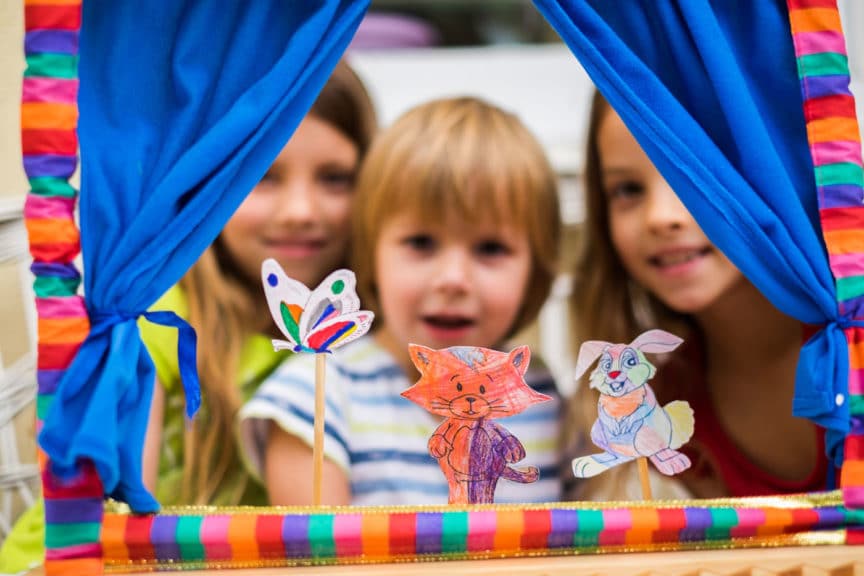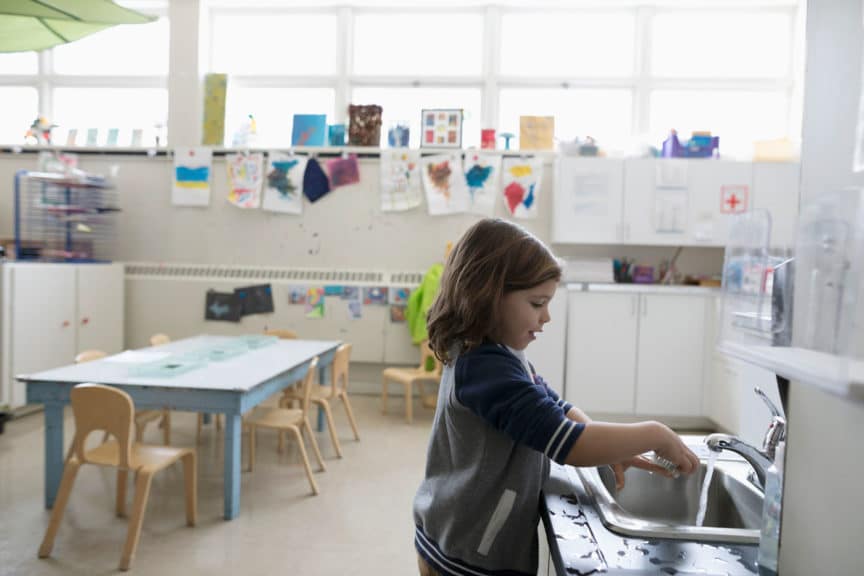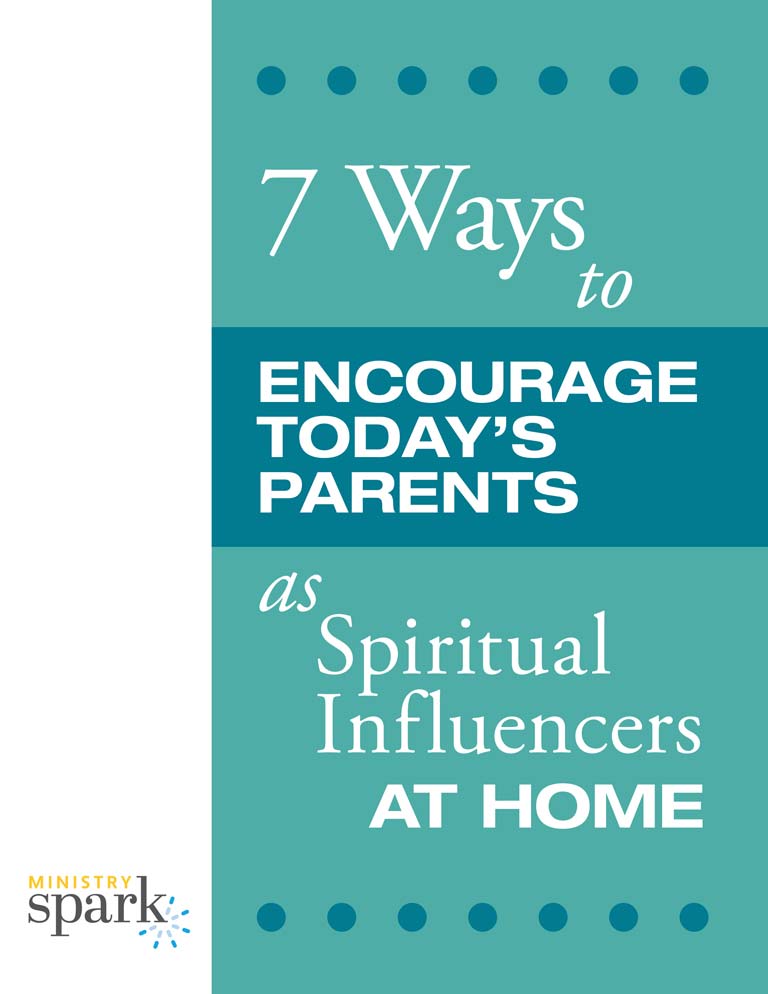I love ministry to the littlest ones in our churches—I’m sure you do as well.
There’s nothing better than snuggling a fresh baby, helping toddlers take first steps of independence, and engaging the enthusiasm of preschoolers!
Children grow so quickly during these early years that days go by like a blur for their parents.

This helps create an amazing opportunity for us as a faith community to encourage parents, love their littles, and point the entire family toward Jesus.
Basics of Ministry in Early Childhood—a Philosophy of Ministry
How we frame our early childhood ministry is important.
Whether you are the leader of a multi-site church with multiple classrooms for young ones or serve as a volunteer in a smaller church with one classroom, what you do is important.
Early childhood ministry should be viewed as a supportive training ground for parents and a place for children to experience the tangible love of God.
The role you play as a caregiver and shepherd of little hearts is significant. You are engaging in the valuable work of raising young children—and helping their families—to know, love, and follow Jesus.
This is so much more than simply providing childcare while the adults are attending “real” church.
Ministry to littles is part of the church—not just an add-on service. Early childhood ministry should be viewed as a supportive training ground for parents and a place for children to experience the tangible love of God.
This is a time we can teach truths about who God is and how He loves all His people; while in a safe, fun, and encouraging environment. Find ideas here.
Ministering to Infants
In our nurseries, our littlest ones learn that their needs will be met as they are rocked, held, and loved on.
We can show our caregivers how to turn Scripture into prayer and speak God’s blessing over the babes in our charge.
Volunteers can pray for children to grow in the love of Jesus, and eventually make their own decisions to know, love, and follow Him.
I also love whisper prayers—either gently speaking close to their ears or matching their gaze and reminding them that they are chosen and loved children of God.
Ministering to Toddlers
Wobblers and toddlers enter a new time of growth and expand the ways we can provide ministry. They are learning more about their bodies and the world around them. Here is a good example of nursery curriculum that helps toddler engage.
Our time with them can be filled with learning simple songs and rhymes about Jesus, utilizing claps and simple body motions.
The childhood games like “so big” can be turned into “You are so big, and Jesus is SOOO big”. Short story times can be introduced with a variety of picture books and sensory items.
Let your toddlers feel and explore items related to the story as they are learning to relate to the world around them.
Ministering to Preschoolers
Preschoolers are some of my favorite people! They are inquisitive—they love to make creations and share in imaginative stories. And, if you can play, you can teach.

During the preschool years, children can really begin to understand Jesus is a real person who really loves them.
Preschoolers can repeat simple truth statements that help them understand God loves them, is always with them, and always cares for them.
They can also begin to carry their own Bibles as they learn that the stories in this special book from God are real, and this is a book we need to treat with respect and care.
Engaging and Encouraging the Families of Littles
As we reinforce the idea that ministry with our youngest learners is more than childcare, we can also begin to engage their families in different ways.
We can help parents know that we care about their children and that we care about their role as parents.
Parents are most impressionable and teachable when they have a newborn, or when they are facing a crisis.
While I pray that families you serve are not in crisis, it behooves us to begin laying a foundation for parenting when parents are most open.
Determine Key Faith Development Milestones
It is valuable to sit down with your staff and/or key volunteers and consider what you desire for kids to experience and learn at these young ages.
If a child began attending your ministry right after birth and remained until kindergarten, what would you expect them to know by age five? What are the best ways to teach the truths you’ve identified and at what ages?
After determining key faith moments, consider how you might come alongside parents to encourage them in their role of faith development in their child.
The church I serve has identified key faith moments for children from birth through 12th grade.
We’ve found that it’s helpful for parents to receive resources and know how we are going to support them at each stage of development.
It’s also been helpful for parents to see what is coming up in the next faith stage, so we can point them down the road of faith formation in their children.
For each stage of development, we identified faith formation goals and listed resources for the parents. As a church, we’ve identified ways we’re going to support children and their families.
Sometimes this is through a parenting class, sometimes it’s through our Sunday programming. Sometimes, it’s simply sharing what they need to hear.
We’ve also detailed the ways we’re going to celebrate each faith marker as a church family and encourage them to celebrate the faith moment at home.
Key Milestones for Parents of Newborns
As it relates to newborns, you may consider ways you can encourage and support the new mommies and daddies. Ideally, encouragement starts before a baby is even born.

Here are a few questions to consider as you brainstorm how to support new parents:
- Would it be helpful to connect new parents with a mentor parent?
- Do you have a parenting program like MOPS that you can refer new moms to?
- Will you announce when a new baby is born into your church family, either at a Sunday Service or in another communication forum?
- Can you resource parents with blessings or prayers they can pray over their newborns?
- Will you encourage parents to dedicate their child or baptize their infant, if you are in a denomination open to this sacrament?
- Do you offer tours of your nursery space for first-time parents, to help decrease any anxiety they may be facing?
Celebration can come when you announce a new birth, or at the time of dedication or baptism. We encourage families to mark and celebrate the dedication or baptism date of their little, just as they mark their birthday.
Key Milestones for Parents of Toddlers and Preschoolers
Toddler and preschool parents also need support and encouragement. As these littles are growing and asking questions, it’s a perfect time to engage in spiritual conversations and create loving environments.
Your love for their littles is contagious, and it translates to love for their parents as well.
Here are a few questions to consider as you identify spiritual moments for toddlers and preschoolers:
- At what age will you begin more structured lessons in Sunday classes?
- What key truths about God will you focus on at church?
- How might you resource parents to teach these truths at home?
- Can you identify simple Bible verses for toddlers and parents to learn together?
- Do you say a simple prayer in class before snack or after a lesson?
- Can you share prayers and blessings with families so they can incorporate them at home?
- If your church has a commercial license subscription (such as a Spotify Business Account) to play or stream music, can you create a playlist of Christian children’s songs to use at home and in class?
- How might you celebrate with children as they learn verses, songs, and truths of God?
Children at this age are growing in their independence, but they still love to belong. Find ways to celebrate what they’re learning and how they’re growing with the rest of your church body.

Perhaps littles can recite a verse in service? Or if it’s too intimidating for them to be on stage, make a simple video to share what they’ve learned.
If you have a large toddler or preschool ministry, schedule a special family celebration event so children can share what they’ve learned.
In the Classroom with Toddlers and Preschoolers
These little learners are ready to explore everything, and they love to create! As you tell a Bible story or engage in an object lesson, remember that kids need a variety of movement.
When you involve their senses as well as their gross motor skills and fine motor skills while telling a story, they will be more engaged and probably recall the main points of a lesson better.
It’s important to remember that while littles are often hands-on learners, it’s about the process not necessarily the end result.
It’s okay if their creations looks wonky to you, they’ll know all about it and be able to tell their families!
Engaging Toddlers in the Classroom
To engage a toddler’s senses, utilize a variety of textures and art mediums. Start with chunky crayons and color on sandpaper, or have kids draw with large pieces of sidewalk chalk on construction paper.
Press their hands on large, non-toxic stamp pads to create a variety of designs or animals on paper—just be sure to help guide their little hands (and keep wipes close by)!
These different textures create sensory input that helps their little bodies learn. But remember, at this age many items go in their mouths, so keep a close eye on the supplies and the children!
Engaging Preschoolers in the Classroom
For preschoolers, get even more creative with art mediums.
Use pudding as finger paint and let them create a scene as you tell a story. Mix in a variety of brushes for painting—try out cotton swabs, cotton balls, craft feathers, or chenille wires.
Purchase seasonal tubs of foam shapes or stickers and encourage littles to create a scene as they listen to God’s word.

I’ve even used cooked spaghetti noodles to make a lion mane as I taught about Daniel. (The starch in the spaghetti acts like glue and sticks to the paper!)
As they’re finishing their projects, ask your preschoolers about their creations!
Another way to get preschoolers to engage their senses is to ask “I wonder …” questions. “I wonder how the blind man felt when Jesus healed his sight?”
Or, “I wonder how you might feel if you walked a long way to hear Jesus speak and you didn’t have any food for supper? Then how would you feel when you saw Jesus feed over 5,000 people and even have food left over?”
Coping with the Wiggles During Class Time
We also know toddlers and preschoolers can be quite wiggly during lessons or storytime. And yet they also love routines.
Consider using carpet squares for “story seats” and asking them to sit crisscross apple sauce. I’ve also used inexpensive placemats from a dollar store or Ikea.
You might also try fidget toys that only come out during special times—something they have to carefully hold onto. Also, colored duct tape can help set physical boundaries.
Place tape on the floor to outline where they can put their story seats or use the tape to make a line to show where a boundary is. This helps kids know the expectations of the class while still empowering them to make choices.
Managing Behavior of Our Toddlers and Preschoolers
Giving toddlers and preschoolers choices is an important part of helping them learn self-regulation. Provide them with two choices, either of which you would be okay with.
For instance, “Would you like red paper or green paper for your craft?” “Would you like to put the toys away by yourself, or would you like me to help you?”
We can also work to reserve “No” and “Don’t” for dangers and use positive words for redirection. Rather than saying “No” or “Don’t do that”, look for positive ways to help children learn.
Instead of “Don’t run the car on the table” try “Let’s use the car on the floor instead of the table”. Instead of “Don’t hit” try “Let’s use soft hands and be kind to our friends”.
Our words with littles really do matter!
A word about escalating behavior in the classroom: All behavior is a form of communication.
A toddler or preschooler may have a need that they don’t know how to communicate to you. They may not even really know what they need themselves!
Instead of just saying, “I need a nap,” they may start throwing toys or hitting another child. They don’t really mean to do these things out of anger or to behave badly—they just can’t yet tell you what they do need.
If we can remember—and help our volunteers know—that all behavior is communication, we begin to look at a child’s actions differently and discern what they may be communicating.
This will help us remain calm as we assess what may help soothe a frustrated or upset child.
What Our Space Communicates
As we care for littles and their families, the nurseries, classrooms, and other spaces where families engage are an important reflection of our ministry.
Think of when someone is coming to your home for a visit. You pick up and keep things tidy.

You probably also start to notice all those little things that had gone unnoticed: a cobweb in the corner, the messy stack of books on your table, the pile of shoes at the front door.
The same is true of our kids’ ministry spaces, and we need to regularly look at our rooms with fresh eyes.
Are your children’s spaces easy to find? Would a new visitor know where to take their kids or how to register them?
As you look at your classrooms with fresh eyes, what do they intentionally communicate about how you care for and teach children? What do they communicate unintentionally?
When we are not intentional about keeping our spaces clean and organized, we’re unintentionally telling families we’re not ready for them or their children. Check out some ideas for renovating your spaces here.
Nurseries and Cry Rooms
Our space also impacts how we care for infants and their parents.
While many parents keep their littles with them longer, we still need to be intentional in creating well-appointed spaces to convey to new parents we value and care for them.
Here are some questions to consider as you evaluate your spaces for infants and their families:
- Do you have a space that is clean and comfortable for changing a diaper?
- Is there a quiet and comfortable space where women can nurse, or do they have to sit in a restroom stall?
- Can parents remain in your nursery, even if they haven’t been background checked?
- Is the service streamed to your nursery or cry room?
- Can you provide a cry room or parent room for parents who wish to remain with their littles?
- How far are your nursery or cry room spaces from your main service? And are they well marked?
- Are toys clean, organized, and updated? Or does your space look like it’s filled with twenty-year-old hand-me-downs that are broken or worn out?
Our Remodel
The nursery at our church was previously on the lower level. Our lower level is more like a daylight basement, so our nursery had high windows that provided some natural light.
We had a quiet room, but it was used for babies who had fallen asleep. And we didn’t have adequate and comfortable space for nursing moms.
But we did have a café on the main floor where we also streamed the service.
We began seeing more and more young families staying in the mixed-use space with their infants and toddlers. We realized we needed to evaluate the best use for all our spaces so we could better serve families.
When we are not intentional about keeping our spaces clean and organized, we’re unintentionally telling families we’re not ready for them or their children.
There were two upstairs offices that were directly across from the sanctuary that we chose to remodel, so we could create more of a parent lounge.
In this lounge, we stream the services on a television, offer comfortable seating for families—including space for nursing moms—and have a well-organized toy area for children.
We also have a volunteer serving in this space, in case a parent wants to check-in their little for care.

The volunteer often serves as more of a host, welcoming and encouraging families. Our parents are feeling more connected with their babies, the church service, and their church family.
For some ideas on making your church attractive to visitors, you can check out this article.
Early Childhood Classrooms
Toddler and preschool classrooms also need to be well organized and clean.
Look at your walls; what are you communicating to families? Are your paint colors drab and uninviting? Do you have an old mural that feels really outdated? If the original artist is still in your congregation, humbly let them know your new vision.
Then it’s okay to update paint!
Ideally, it’s good to update paint every 5-7 years. This can freshen a space rather economically.
Beyond wall color, do you have posters that are faded, frayed, or torn? Are they printed on plain paper that has discolored over the years? As you update, consider either laminating pages or getting inexpensive frames.
When you paint, it’s also a great time to reorganize and clean rooms. Look at the supplies you use with kids.
What does a bin of broken, peeling crayons communicate to new families? Do you have open shelves? Are items organized, or are shelves overflowing with old papers and remnants of supplies?
Is the counter clean and free of clutter, or is it stacked with unclaimed crafts and forgotten hoodies? Have small, personal toys crept into kids’ play stations?
Include Your Volunteers
Getting all your volunteers on board is key to keeping up your rooms.
During a training, consider doing this exercise to look at rooms. Start either outside of the church building or outside your children’s rooms.
Give everyone a stack of post-it notes and a pen. Ask them to write what they see on a post-it, only one item on each. Walk slowly through your spaces, encouraging volunteers to look at walls, toys, floors, and cabinets.
Then spend some time debriefing together. What needs to change? How can you work together so that you are intentionally communicating to parents the message you want them to know?
At times in ministry, I have created a volunteer position for people who helped watch over spaces.
Similar to an adopt-a-room program, I appointed room coordinators. Individuals or families adopted rooms and made sure they were picked up each week.
They often walked through rooms either before or after service to make sure everything was as it should be. They communicated to me if basic supplies were needed and returned leftover supplies to the supply room.
Some even saw the need for more decorations or amenities and, after approval, donated what was needed.
Through the evaluation process, we all learned to look with fresh eyes and elevated our expectations.
Once we saw what needed to be done to keep our space looking great, we all continued to work together to care for our rooms.
Clean spaces tell parents we care about our area so we will care even more about their children. It tells them we want the best environment for their littles to know and experience the love of Jesus.
Family Ministry Values and Applications
While we may care for children in classrooms during most of the service, the actual church experience has much more to offer.
Families may have children in other classes, as well as extended family attending service with them.
It important to recognize what the entire family is experiencing as they enter our churches, and it’s important to ask ourselves how we can care for the whole family.
The church I serve in values Family Ministry. And as part of that, we find it important to have time in our main service where all ages are present.
Every week our kids join their families for the opening worship time.
It’s a different experience for children to worship with friends in a classroom than to worship with their family—perhaps including grandparents or aunts and uncles—in “big church”.
Even young children learn that it’s important to gather as they hear the word of God, watch parents sing in worship, and give their monetary offering to God’s family.
We feel that if we desire to grow into a family of families, we must allow intentional time with all ages together. Beyond just having all ages present in a room, we want to make sure all ages are engaged.
We don’t want children present in a room and disregarded. We create intentional spaces and moments for children to engage in the life of the church. Raising passionate kids is important.
Family Areas
We have a family area with small tables, quiet toys, and picture books for little ones. We used to have this area in the back of our sanctuary and only on the first Sunday of the month. It felt like it was in the corner.
We made a bold move last year to relocate the family area to the front of the room, just to the right of the stage, for every service. We save rows of seats next to the area for parents of kids who use this area.
Kids are engaged during service and the rest of the congregation can see children are up front—valued, and part of who we are as the body of Christ.
While noise in the back corner was often a distraction, the joyful sounds from the family corner are a delight.
Family Moments
Every Sunday we also create moments for kids. We have a tradition of building a rock wall to commemorate our time to God.
This now occurs toward the end of worship and serves as a bridge to when the kids go to their own classes.
Children are invited up to add a rock, we practice our Remember Verse as a congregation, and then we often give a short blessing on the kids before they leave for class.
We love seeing our toddlers and preschoolers join the elementary kids in this tradition.
Family Services
On the first Sunday of every month, we pause all classes, so all ages remain in the entire service. We also create intentional moments for children to be part of the service each month.

This may look like an object lesson for young kids, a digital puppet show that captivates them and relates to the sermon, or active examples with kids during the sermon.
If we recite The Lord’s Prayer or Apostles Creed, we remind parents with young children to lift them up to see the screen and hear their voices. It’s even okay if they stand on the chairs during this time!
We observe communion during this service, often gathering in groups of 5-9 around a table to receive the communion elements. This is a beautiful time for families to share in the sacrament.
For infants, we pause to pray a blessing over them. For toddlers and preschoolers, we provide a grape and a blessing as a sign of God’s love and promises for them.
We value children as part of our family of believers.
Family Fellowship
We also pay attention to the needs of families after our services. Our church likes providing a place for connection, but we noticed it was difficult for our families with young children.
Rather than lingering in community, they were often leaving right after service. We have worked hard to make our connection time intentional and inviting for all ages.
We now have PlasmaCar scooters for young children to ride on and provide simple board games and Magformers to play with.
Sometimes we take application activities from curriculum and provide resources for families to complete them together.
It is a really beautiful picture to see families helping each other’s children, older siblings and their friends interacting with preschoolers, and grandparents delighting in watching their grandkids play with church friends.
Knowing and Understanding the Parents of our Littles
Many parents of our littles are now millennials. If you are not a millennial yourself, this may surprise you a bit.
How can they be old enough to have kids? Aren’t they still living in their parents’ house not really working!?!
Whatever your impression of millennials may be, we need to know who they are so we can relate to them as we care for their young children.
Millennials are those born from 1981 to 1996—give or take a few years depending on which research firm is consulted.
Kids in these years grew up with easily accessible technology in the home, giving them the label of “digital natives”. As adults, laptops, tablets, and smartphones are normal necessities, not optional indulgences.
Google is at the ready for any question or concern they have. As first-time parents, this often means they are going to the internet for advice or information.
They know the developmental ages and stages of their littles, may have a Dock-a-Tot and multiple swaddles, as well as know what ages their toddlers may hit a sleep regression. Yes, those are all real things.
Millennial parents are looking for connection for their kids and their entire family—the church can be the place to do this.
As they know key development milestones, they also want to know that you know what their child may need.
Do volunteers in classes know about the age group they’re serving with? What training techniques are you using to equip your volunteers? Have you practiced positive limit setting? Are you providing opportunities for the family to flourish together?
Parenting Advice
Another key trait of millennials: they don’t want parenting advice you used 25 years ago. Or even 10 years ago.
They don’t want to be told what to do or how to do it. Instead, they want someone to walk alongside them, to show them, and to help lead them through an experience.

Also, they deeply value authentic community and connectedness.
This may mean our well-used and well-intentioned parenting classes are not as effective as they once were. A sage-on-the-stage parenting lecture just isn’t as compelling to them.
We may need to evaluate the resources we offer our families and become more of a guide-on-the-side.
Are we reading the latest research and updating book, website, or podcast recommendations? Are we looking at our environments with fresh eyes, ensuring they are safe and welcoming?
Special Events
This also means special events need to serve a purpose.
We can use events to model spiritual practices or as ways to engage with neighbors. Then we can resource families with supplies and websites to empower them to put into practice what they’ve just experienced.
Afterward, a follow up or debrief can really help reinforce learning.
In all of this, a shared experience leads to a shared story, which leads to a shared identity. Millennial parents are looking for connection for their kids and their entire family—the church can be the place to do this.
Events like this may look like a preschool parent night with interactive stations. There could be stations to make a snack together, create a craft, explore sensory bins, play a game, and build something.
Each of these stations could revolve around a theme like sharing the Good News with our neighbors. As they engage in the stations, they’re learning ways to engage with neighbors.
Maybe they’re even making something to share with their neighbors!
Provide needed supplies to recreate activities with their neighbors.
Remember to follow up with your families after the event. This may be as simple as asking how it went next time you see them, or maybe you encourage people to share with a hashtag on Instagram. #familyfun!
What You Do Matters
While littles are in our care, we are doing so much more than just trading time or plugging a space another volunteer backed out on. This is a holy calling from our holy God to care for His beloved children.
Listen for the voice of the Holy Spirit, following as He leads you to care for children and their families.
What you do matters. These children in our care are worth the investment of our time and energy as we learn more about Jesus ourselves, prepare lessons, and share the love of God with them.
I encourage you to take every opportunity you can to spend time with littles and their families. Create spaces they want to hang out in and events they want to attend.
Your love for their littles is contagious, and it translates to love for the parents as well.
Blessing the Littles in Your Ministry
Children are capable of very real experiences with God at very young ages. Take the opportunity to speak blessings and words of life over the littles in your care.
Create spaces where they feel safe and loved, where we are the physical representation of our God who works through us. Listen for the voice of the Holy Spirit, following as He leads you to care for children and their families.
When I speak a blessing over a child, I encourage them to hold out their hands, forming a cup. A blessing can be a part of Scripture, a commission, or words of encouragement.
I want them to have a cup to catch the words of blessing. Then I tell them to pour those words of blessing into their hearts.
It’s so sweet to see littles ready and waiting with cupped hands to receive the words of our Heavenly Father.
Friend, I invite you to hold out your hands now and receive these words of blessing: You have been called and equipped for every good work as you love and lead the littles in your care. I bless you as you continue to tell the next generation of the praiseworthy deeds of the Lord, His power, and the wonders He has done. Amen.

Ready to help parents create an environment for spiritual growth?

Ready to help parents create an environment for spiritual growth?











